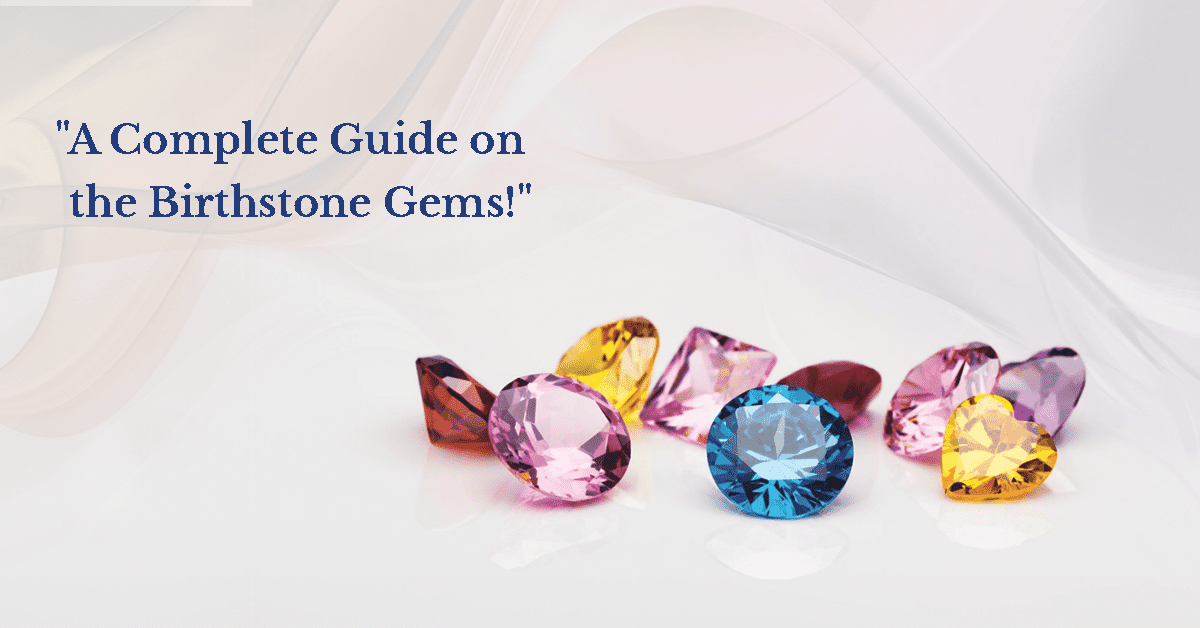Birthstones are a colourful, fun and alluring introduction to the world of gemstones. They appeal to people across the globe, irrespective of their gender or age.
Simply put, birthstones are gemstones that are associated with a person’s birth month. Each has a unique meaning and historical significance.
There are numerous myths and legends surrounding the power and benefits of birthstones. Several ancient civilisations believed that these gems have unique powers that bring about health, luck, and prosperity in the lives of the wearer. Further, birthstones were gifted to loved ones on special occasions to mark the love and the respect between the people.
Even if you might not agree with the myths, it’s hard to deny that learning about gemstones is educational as well as an entertaining experience.
However, over the years, there has been a significant change in the birthstones of traditional and modern society.
If you’re purchasing a birthstone or determining which birthstone fits you, you’ve come to the right place. Read on to uncover the history and the mysteries surrounding birthstones.
History of Birthstones
Some experts believe that birthstones have a biblical source. In the Book of Exodus, the Bible, there is a mention of 12 gemstones embedded on the breastplate of Aaron. These gemstones are; diamond, sapphire, emerald, amethyst, topaz, carbuncle, sardius, onyx, beryl, jasper, agate, and ligure representing the twelve tribes of Israel of that era.
But, you may wonder, how did these gemstones transform into the birthstones that we see today? Fast forward to the 1st and 5th centuries AD, two scholars, namely Flavius Josephus and St.Jerome are credited with associating the twelve (breastplate) gemstones with the twelve zodiac signs. Initially, the reasoning was that each person would own all the 12 gemstones and wear them according to the month.
The modern variation that we know today emerged in the 18th century in Poland, whereby the Jewish gem traders started selling gemstones based on the person’s birth month.
Later, in 1912, the National Association of Jewellers solidified this practice in the US. Since then, the twelve gemstones have largely remained the same. However, occasionally, some companies have tried to pitch their gems into the mix to boost their sales.
Birthstones by Months
1. January - Garnet
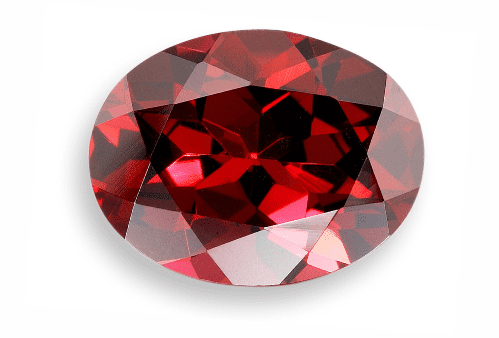
For people born in January, Garnets serve as their birthstone. They’re not only colourful and appealing, but also have a bunch of qualities. As per Indian astrology, garnets help in relieving mental stress and negative feelings. Further, it helps in promoting mental clarity, instils greater self-confidence and brings about peace of mind. In ancient times, garnets were considered beneficial in treating inflammatory diseases and calming a burning heart.
The name garnet comes from the Latin word ‘granatus’ referring to the red hue of a pomegranate. Throughout history, garnets have been cherished by the people. For instance, the pharaohs of ancient Egypt adorned their necklaces with stunning red garnets. The clergy and the nobility of the Middle Ages had a special preference for garnets. Moreover, the antique hair comb of the Smithsonian is one of the most famous pieces of garnet jewellery.
In ancient times, Bohemia was the primary source of red pyrope garnets that were popular during the Victorian era. However, today garnets are sourced from many parts of the world. Countries like Afghanistan, Pakistan, India, Myanmar, Brazil, Sri Lanka, Kenya, and Tanzania are the treasure house of garnets.
2. February - Amethyst
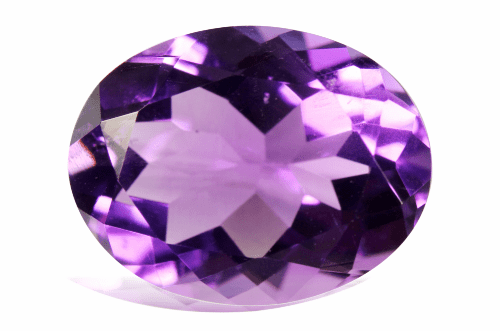
The February birthstone, Amethyst, is a deep purple colour gemstone. It owes its name to the Greek word ‘Amethyos’ meaning a ‘remedy against drunkenness.
Due to its wine-like colour, it has been associated a lot with Bacchus (the god of wines) in Greek mythology. People believed that Amethyst can keep the mind of the wearer clear and make them quick-witted so that they can make sound decisions in battles and business affairs.
Amethyst can be found in Russia, South America, Brazil and Africa.
3. March - Aquamarine
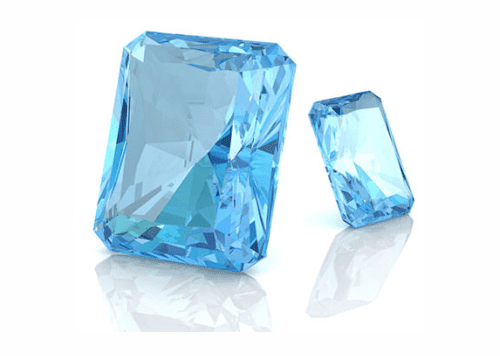
Aquamarine birthstones are a symbol of the purity and chastity of the soul. They come in a wide array of colours ranging from deep-green blue to ones with only slight greenish hues. Their peculiarity lies in the fact that they’re visibly free from inclusions and appear as clear as water.
The name aquamarine is sourced from the Latin word for seawater. As per the ancient mariners, the stone had the mystical power to calm the protruding waves and protect the sailors.
Some believed that the march birthstone could bring happiness in marriage, while others felt it could protect the wearer in battles.
Aquamarines are found throughout the world, including in countries like Brazil, Pakistan, Kenya, China, Myanmar, Russia, Ukraine, etc.
4. April - Diamond
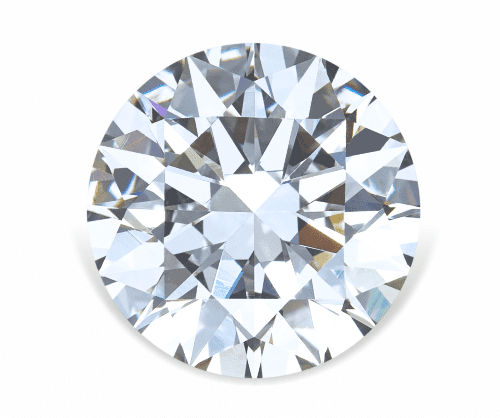
The history of diamonds can be traced back to India, where they were gathered from the country’s rivers and streams. In ancient times, diamonds were coveted by the rich and the elite. Later, the diamonds were supplied to the European markets by the caravans.
However, by the early 1700s, India’s diamond supplies began to decline. During this time, Brazil emerged as a treasure house of diamonds.
Throughout history, people have associated some significance with diamonds. For instance, people believed that diamonds could ward off evil and malevolent spirits. Similarly, people believed it had healing powers and was considered an antidote for poison.
Today, diamonds are cherished across the globe for their beauty, strength, status, and the qualities it symbolizes, such as happiness and longevity.
Diamond reserves are found throughout the world including in countries like Australia, Botswana, Russia, Brazil, China, the Democratic Republic of Congo, and more. You can read our blog on diamond mines in that world to know in detail about this topic.
We have written a dedicated blog on the birthstone of April – Diamond. It is loaded with lot of historic facts and myths related to the birthstone.
5. May - Emerald
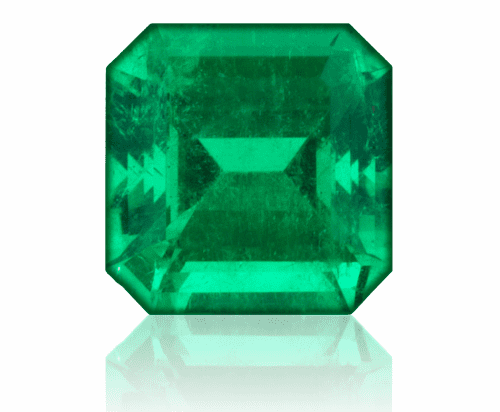
Emeralds serve as the birthstone for people born in May. The lustrous beauty and the appeal of emeralds are unparalleled.
The name Emerald comes from an ancient Greek word ‘smaragdos’ which means a green gem. An ancient Roman author, Pliny the Elder, mentioned the benefits of the May birthstone in his book Natural History. According to him, emeralds have therapeutic properties that help gem cutters to relieve stress and reduce eye pain. Today, science has approved his belief.
Also, in ancient times, people believed that emeralds possessed magical powers. For instance, some believed that one could see the future by placing it under the tongue, whereas others believed it could transform an average speaker into an eloquent one.
The May birthstone can be found in Columbia, Brazil, Africa, Pakistan, and Afghanistan.
6. June - Pearl
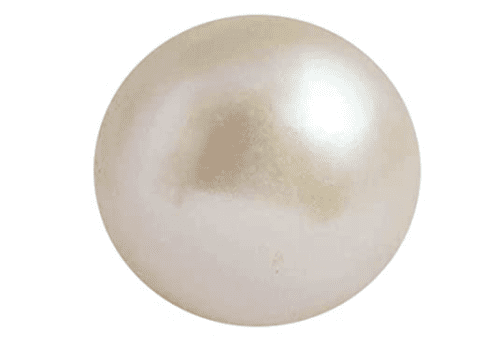
Pearls have an alluring charm that plays a key role in their popularity amongst people of all ages. The history of pearls is quite fascinating. For a long time, middle eastern people believed that pearls are teardrops fallen from heaven. As per the Chinese, it came from the brain of the dragon. Similarly, Christopher Columbus and his contemporaries believed that molluscs formed pearls from the dewdrops.
However, today, it’s confirmed that pearls are organic gems that are found in the oceans, lakes and rivers around the world. Further, it grows inside the tissue of either a saltwater or freshwater mollusc.
Throughout history, people have associated some or other significance with pearls. Some believed that pearls are a symbol of innocence, purity, and humility, while others thought it has curing powers. In fact, the physicians of the ancient Arab world believed that pearl powder was extremely helpful in improving eyesight, quieting the nervous system, and easing depression.
Check our comprehensive guide on pearls to understand this gem in greater detail.
7. July - Ruby
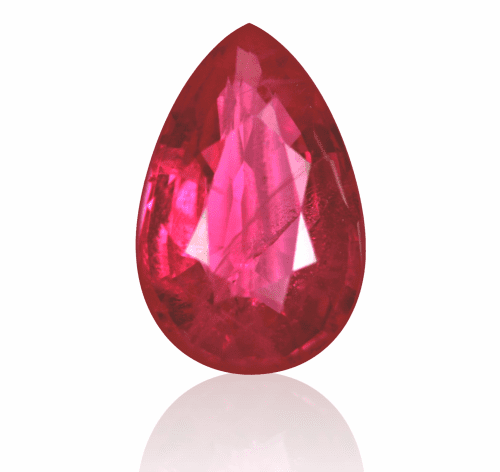
The ancient Indians regarded rubies as the ‘king of all precious stones. Its color and beauty are unparalleled. Further, it’s also associated with a bunch of magical powers.
Some believed that the July birthstone could predict misfortune and danger, while others felt that it was beneficial in curing inflammatory diseases and soothing anger. The Burmese soldiers adorned their weapons with rubies, as it might make them invincible in the battles. According to medieval Europeans, rubies bestow health, wealth, wisdom, and success in love to the possessors.
For a long time, ruby has been considered a symbol of power and youthful energy.
The July birthstone is found worldwide, including in Myanmar, Afghanistan, Sri Lanka, Kenya, Tanzania, Madagascar, and Tajikistan.
We have written a dedicated blog on rubies where we explain their origin, features, pricing, and much more.
8. August - Peridot
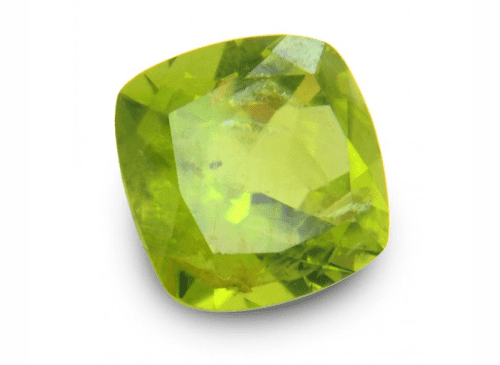
Peridots are a gem variety of the mineral olivine that ranges from yellowish green to greenish yellow. For a long time, it has been confused with topaz and emerald. For instance, the shrine of the three holy kings in Germany’s cologne cathedral is adorned with over 200 carats of gems that were believed to be emeralds but are actually peridots.
The name peridot is sourced from the Arabic word ‘faridat’ meaning gem. People in the ancient and mediaeval had a lot of regard for this stone. For instance, priests adorned their jewellery with them and they were also used in the decoration of churches in mediaeval Europe.
In ancient times, people considered the peridot to be a protective stone that can ward off evil and keep the owner safe.
Peridots can be found in Australia, South America, Southwest Asia, and Africa.
9. September - Sapphire
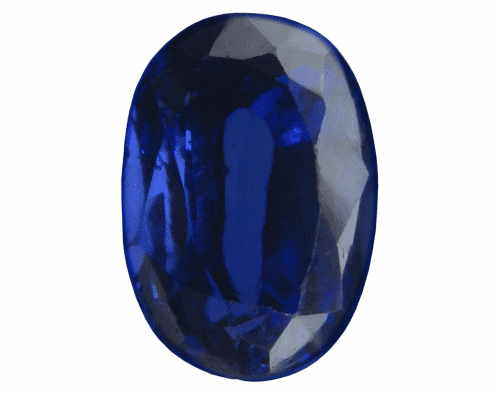
Sapphires are the birthstone for people born in the month of September. This unique blue stone has been admired for its beauty and powers throughout history.
For instance, the elites of ancient Greece and Rome believed that blue sapphires have magical powers that can protect their owners from harm and evil. Similarly, the clerics of the middle ages adorned themselves with sapphire because they symbolized Heaven.
The ancient Persians held the view that the earth rested on a huge sapphire which resulted in the blue color of the sky.
Apart from these, sapphires were believed to have healing powers as well. As per the Mediaeval Europeans, sapphires were helpful in treating plague boils and eye diseases. In fact, sapphires were also considered an antidote for poison.
The September birthstone can be found worldwide, especially in Kashmir, Myanmar, Australia, Thailand, Cambodia, Madagascar, etc.
Interested in knowing more about sapphires? You can read our blog on sapphires which explores the topic of its features, pricing, significance and much more.
10. October - Opal and Tourmaline
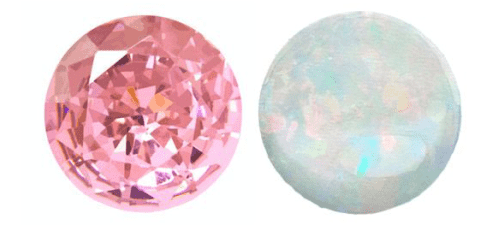
The opal and tourmaline are characterised as the October birthstones.
The name opal has been derived from the Sanskrit word ‘upala’ which means a precious stone. However, in ancient Rome, it became ‘opalus’. The beauty of this stone lies in its ability to change colour in every shade of the rainbow.
In fact, many writers in history have compared this stone to fireworks, volcanoes and galaxies. As per Bedouin, opals held lightning, and they fell during thunderstorms. On the other hand, the ancient Greeks believed that opals bestowed the gift of prophecy to the possessor and offered protection from ailments.
According to the Europeans, opals were a symbol of love, purity and truth.
This October birthstone can be found in numerous parts of the world, including Mexico, Brazil, Central Europe, Indonesia, Peru, Turkey and the US.
Tourmaline is another October birthstone whose name has come from the Sinhalese word ‘tormalli’ meaning a stone with mixed colours. Tourmaline is widely admired for its dazzling beauty and its ability to emit multiple colours.
Ancient mystics believed that this October birthstone can inspire artistic expression as it has a colour for every mood. Tourmalines are available in a wide variety of colours, ranging from pink, red, and green, to blue, and violet.
Sometimes red and green tourmalines are mistaken for ruby and emerald. For instance, the Caesar Ruby Pendant, one of the key ornaments of the Russian crown jewels, is actually a rubellite tourmaline.
The different colours of tourmaline are believed to have various qualities. For instance, green tourmaline boosts courage, strength and stamina, whereas pink tourmaline symbolises love, compassion and gentleness.
11. November - Topaz and Citrine
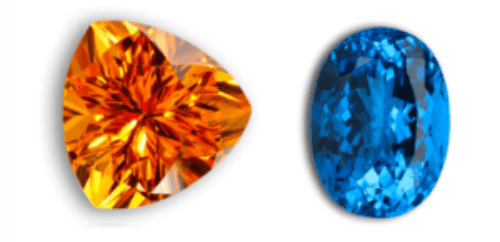
The Topaz and Citrine gemstones are the two birthstones for people born in the month of November.
As per some sources, the word topaz has been derived from the Sanskrit word ‘tapas’ which means fire. However, others believe that it has been derived from the Greek word ‘topazos’.
The November birthstones have long been considered to have many benefits. For instance, as per the ancient Greeks, the topaz stone gives strength to the possessor. On the other hand, Europeans believed it could thwart magical spells and dispel anger. Indians believed that those who wore topaz above their heart would be endowed with beauty, intelligence and a long and healthy life.
The topaz stone is available in a wide variety of colours, ranging from blue, yellow, orange, pink, brown, and red to even colourless.
Topaz can be found in several parts of the world, including Brazil, Nigeria, Namibia, Mexico, Myanmar, Sri Lanka, and the US.
12. December - Turquoise, Tanzanite and Zircon
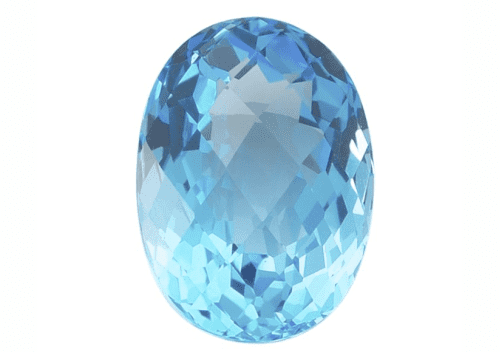
Turquoise, tanzanite and zircon are the three birthstones for people born in the month of December.
Turquoise is a semi-translucent gem that ranges from blue to green. It encompasses the veins of matrices that refer to remnants of rock in which it is formed.
Back in the day, people associated a lot of powers and qualities with this stone. For instance, the Hindu mystics believed that seeing a turquoise after beholding a new moon will bring fantastic health to the person. Similarly, others believed turquoise stones protect the wearer from falling (especially from horses in battles). It breaks into several pieces to warn the people about the impending disaster.
In the European tradition, gifting a turquoise ring symbolises the unbreakable bond between individuals. Further, in Tibet, turquoise stones are considered the national treasure and they offer good health, good fortune and protection from evil.
In the past, Iran was the leading supplier of turquoise gemstones. But today, China has emerged as a leading supplier of the December birthstone.
Moving on, Tanzanite is a relatively new gemstone in the world of coloured stones. It is often referred to as a “velvety” stone owing to its deep and saturated colour. Due to its vivid colour, high clarity and potential for large cut stones, Tanzanite has become the talk of the town. Tanzanite is naturally brown and is heat treated to achieve blue/ purple colour.
Tanzanites are exclusively found in the Merelani hills of northern Tanzania.
Last but not least is Zircon.
During middle age, people associated a bunch of powers and qualities with this stone. For instance, they thought zircons can scare off the evil spirit and calm the mind so as to ensure deep sleep. In Hinduism, zircons can alternate with the hessonite garnet as one of the nine gems of the Navratra. When worn simultaneously, the nine gems protect the wearer and bring positive energy, wealth and good health.
Zircons can be found in abundance in countries like Sri Lanka, Australia, Myanmar, Vietnam and Cambodia.
To select the right birthstone, you can look out for its colour, aura and the powers they possess. Further, you must look for the birthstone compatible with your zodiac sign.
FAQ’s
The National Association for Jewellers, USA, standardised the 12 birthstones as per the 12 months in the calendar.
Original rubies can be safely considered one of the most expensive birthstones. However, diamonds, emeralds, pearls and sapphires are also expensive.
As per astrology, birthstones are well connected to one’s energies. They enhance one’s energy level and make them align with the environment by including the perfect wavelength for them.

